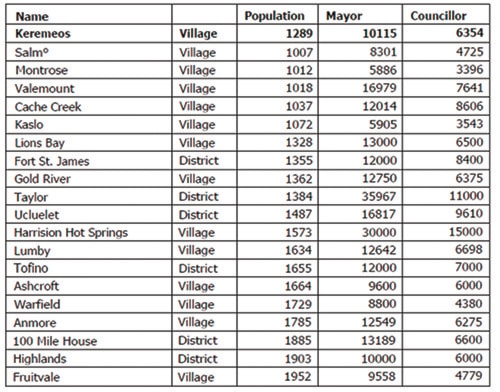Keremeos village staff researched remuneration amounts paid to the mayor and council of similar sized communities in B.C. in an effort to gauge the “fairness” of remuneration paid to officials in the village.
Staff concluded that the mayor and council did indeed rate an increase, as their remuneration fell below the average for the communities surveyed. (See table)
Fortunately for the mayor and council, they decided not to heed this advice and instead took the high road, denying themselves an increase in spite of “evidence” that they might have used to justify more money.
I see problems with staff’s method of assessing remuneration for the mayor and council.
All communities are not created equal; therefore an assessment of remuneration cannot be considered complete based purely on direct comparisions to stipends paid to equivalently sized communities.
Taking a look at the list, it is apparent that the communities paying their politicians the highest remuneration are the ones that have a diversified tax base - simply speaking, they have taxable resources that go beyond those of the residential homeowner.
Fort St. James, Gold River Lumby, and 100 Mile House all have an industrial base; Cache Creek has extra cash through revenue received from being a depository for Lower Mainland garbage.
On the other hand, the communities more similar to Keremeos’ economy - Kaslo, Ashcroft, Fruitvale, Salmo and Montrose - all have remuneration that is less than what Keremeos’ politicians get.
Harrison Hot Springs compensation for their politicians is anomalously high, compared to every other community on the list. (Removing that one entry changes the average remuneration paid to mayors, for instance, by nearly $1,000.)
One could argue that it shouldn’t even be on the list.
Comparing remuneration based on a simple average of similar sized communities doesn’t cut it.
Remuneration for politicians - and wages for municipal staff, for that matter - should be based on factors that more completely describe a community’s ability to pay.
